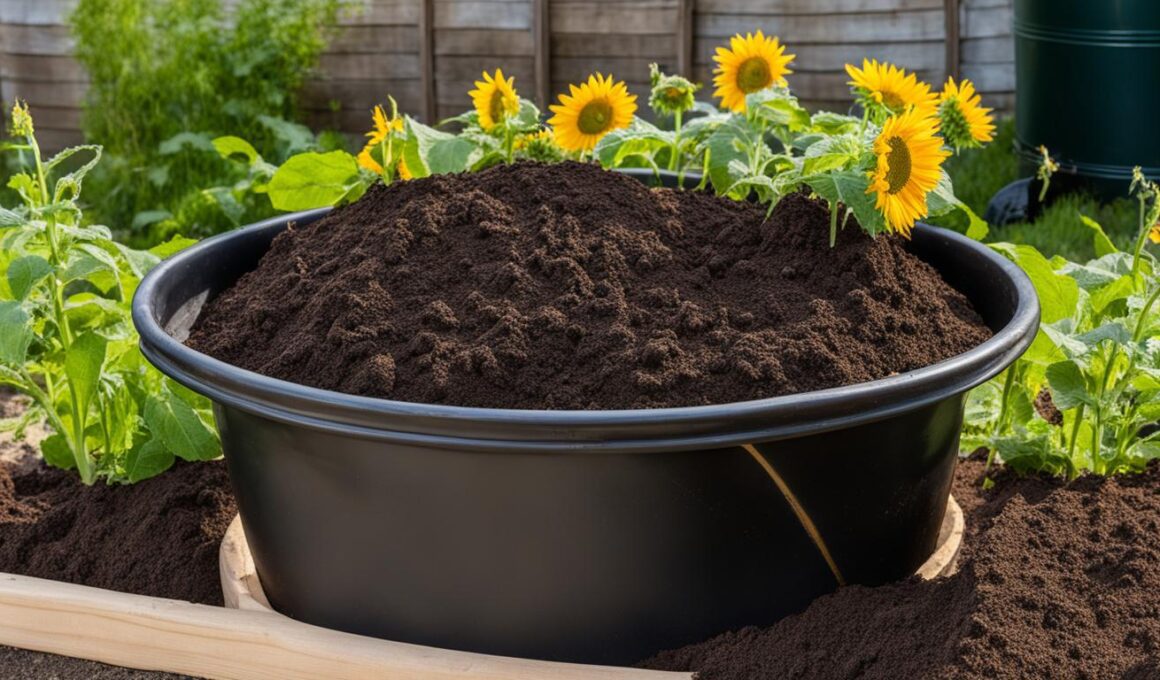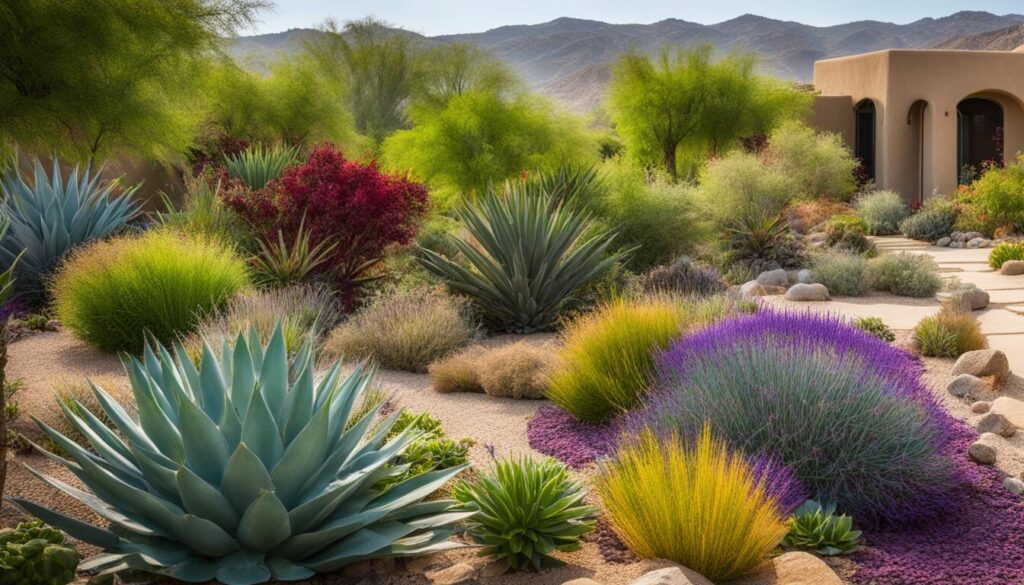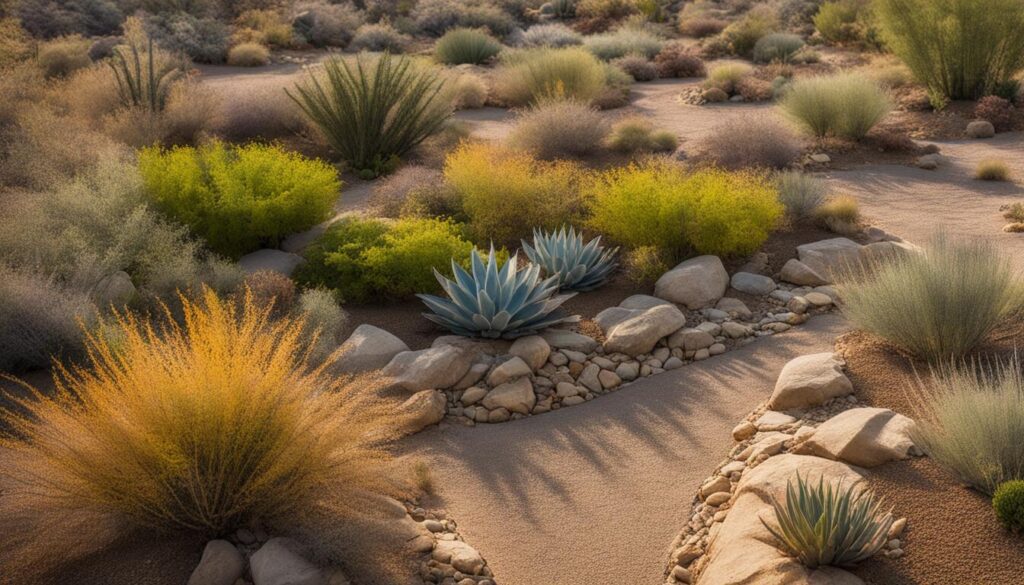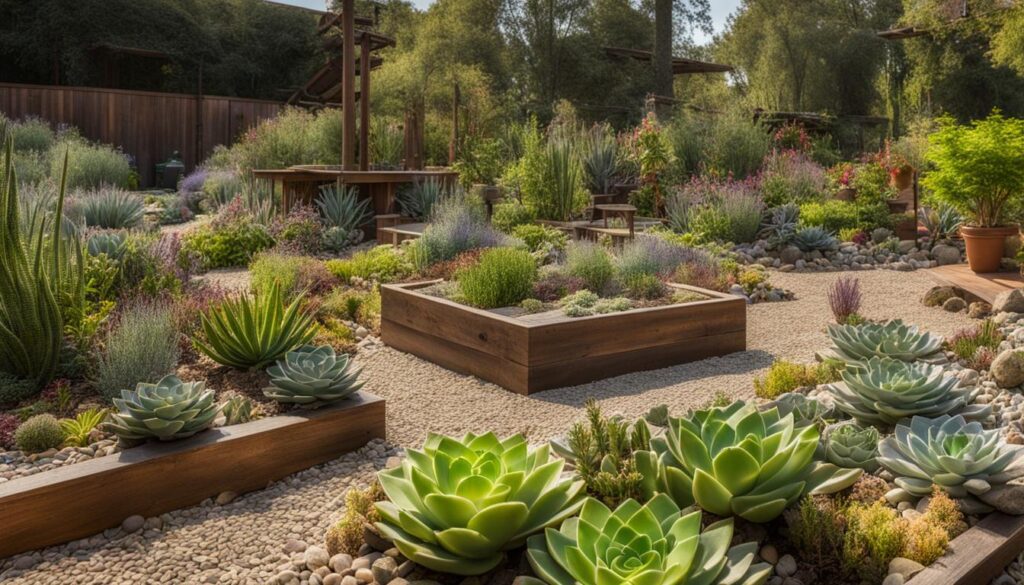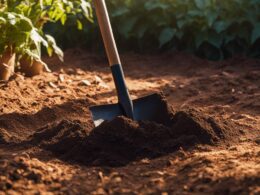Welcome to our comprehensive guide on mastering sustainable soil management in xeriscaping. If you’re looking to revamp your garden, conserve water, and maintain soil health, xeriscaping is the perfect solution for you. In this guide, we will cover all the essential steps and techniques to help you create a stunning and environmentally-friendly landscape. Let’s dive in!
Key Takeaways:
- Xeriscaping is an effective way to conserve water and transform your yard while maintaining its beauty.
- By selecting native plants, using drip irrigation, and creating a water-efficient design, you can significantly reduce water bills and eliminate the need for pesticides.
- Implementing xeriscaping involves steps like researching and selecting water-wise plants, removing existing lawns, and planning for efficient water usage.
- The soil plays a crucial role in xeriscaping, and understanding soil types and preparing the soil accordingly is essential.
- Mulching and efficient watering techniques are important in xeriscaping to reduce evaporation and conserve water.
Benefits of Xeriscaping in Long Island
Xeriscaping in Long Island offers numerous benefits for homeowners and the environment. By implementing water-wise landscaping techniques, you can conserve water, save money on your water bills, and support the local ecosystem. Here are some key advantages of xeriscaping:
- Water Conservation: Xeriscaping significantly reduces water usage compared to traditional landscaping methods. By selecting native plants that are adapted to the local climate, you can create a resilient landscape that requires minimal irrigation. This not only conserves water but also helps to mitigate the effects of drought and water scarcity.
- Cost Savings: Xeriscaping can lead to substantial cost savings on your water bills. With reduced water usage, you’ll notice a significant decrease in your monthly water expenses. Additionally, xeriscapes require less maintenance, resulting in savings on lawn care and landscaping services.
- Promotion of Biodiversity: Xeriscaping with native plants supports the local ecosystem and promotes biodiversity. Native plants provide habitat and food sources for various wildlife species, such as birds, butterflies, and bees. By creating a healthy and vibrant ecosystem, xeriscaping contributes to the conservation of biodiversity in the Long Island region.
Furthermore, xeriscapes are known for their ability to withstand tough weather conditions, including heatwaves and drought periods. The resilient nature of xeriscaping plants ensures that your landscape remains beautiful and thriving, even in challenging environments.
Steps to Implement Xeriscaping in Your Landscape
Implementing xeriscaping in your landscape can be a rewarding and sustainable choice. By following these steps, you can create a beautiful and water-efficient garden:
- Research and select the right plants: Choose native plants that are well-adapted to your region’s climate and require less water. Look for drought-tolerant varieties that can thrive with minimal irrigation.
- Remove the existing lawn: Consider removing your traditional turf lawn and replacing it with alternative ground covers or hardscaping options. This helps conserve water and reduces the need for frequent mowing and maintenance.
- Plan your irrigation system: Drip irrigation is a recommended technique for efficient water usage in xeriscaping. It delivers water directly to the roots of plants, minimizing waste and evaporation. Consider the layout of your landscape and ensure proper coverage.
- Maximize water efficiency: Design your landscape to maximize water efficiency by grouping plants with similar water needs together. This minimizes competition and ensures each plant receives the appropriate amount of water. Incorporate mulching to reduce evaporation and weed growth.
Implementing xeriscaping in your landscape requires careful consideration and planning. By following these steps, you can create a sustainable and beautiful outdoor space that conserves water, reduces maintenance efforts, and supports local biodiversity.
Importance of Soil in Xeriscaping
The success of xeriscaping relies heavily on the condition and health of the soil. Understanding the soil types in your area is essential for creating a thriving xeriscape garden. Different soil types have different characteristics, such as drainage and water retention capabilities, which can significantly impact plant growth and health.
In order to prepare the soil for xeriscaping, it is crucial to assess its quality and make any necessary improvements. Adding organic matter, such as compost or well-rotted manure, can enhance the soil’s structure, water-holding capacity, and nutrient content. This helps to create a healthy environment for the xeriscape plants to establish strong root systems and withstand periods of drought.
Proper soil preparation also allows for better water infiltration and reduces the risk of waterlogging, which can be detrimental to xeriscaping plants. By ensuring the soil is well-drained and has good water-holding capacity, you can optimize water usage in your garden and minimize water wastage.
Soil Types for Xeriscaping
There are various soil types commonly found in gardens, including sandy soil, clay soil, and loamy soil. Each soil type has its own characteristics and considerations for xeriscaping. Sandy soil, for example, drains quickly and may require more frequent watering, while clay soil retains water for longer periods but can become compacted and poorly drained.
Understanding the properties of your soil type can guide you in selecting the right plants for your xeriscape garden and implementing appropriate watering techniques. It also helps in determining the need for soil amendments to improve the overall quality of the soil, such as increasing organic matter content or improving drainage through loosening compacted soil.
Enhancing Soil Health with Organic Matter
Addition of organic matter is a key strategy for improving soil health in xeriscaping. Organic matter enriches the soil by providing essential nutrients, improving soil structure, and enhancing water retention. It also promotes the growth of beneficial microorganisms, which play a vital role in nutrient cycling and maintaining a healthy soil ecosystem.
Compost, leaf mold, and well-rotted manure are ideal sources of organic matter for xeriscape gardens. These materials enhance soil fertility and structure, allowing for better root growth and nutrient absorption. Organic matter also helps to reduce soil erosion, minimize weed growth, and increase the soil’s capacity to retain moisture, which is particularly important in water-conserving xeriscape designs.
By prioritizing soil health in your xeriscape garden through proper soil preparation and the addition of organic matter, you can create an optimal environment for your plants to thrive and ensure long-term success in managing water usage while maintaining a beautiful landscape.
Mulching and Watering Techniques in Xeriscaping
When it comes to xeriscaping, mulching and efficient watering techniques play a crucial role in conserving water and maintaining a healthy landscape. Mulching is a key practice that not only helps to reduce evaporation but also suppresses weed growth, conserving moisture for your plants. By applying a layer of organic mulch around your plants, you can create a protective barrier that retains moisture in the soil and reduces the need for frequent watering. It also adds organic matter to the soil, improving its overall health and fertility.
“Mulch is like a protective shield for your plants. It keeps the soil cool, reduces water evaporation, and prevents weed growth. Plus, it adds nutrients to the soil as it breaks down over time.” – Landscaping Expert
When it comes to watering techniques, the goal is to ensure efficient water usage while meeting the needs of your xeriscape plants. Drip irrigation is highly recommended for xeriscaping as it delivers water directly to the root zones, minimizing water waste through evaporation and runoff. By placing drip emitters near the base of each plant, you can provide water precisely where it is needed, promoting deeper root growth and plant resilience. Additionally, grouping plants with similar water requirements together can further optimize water usage and prevent overwatering.
Maximizing Water Efficiency Tips:
- Apply a layer of mulch around plants to conserve moisture and suppress weed growth.
- Use organic mulch for long-lasting benefits and improved soil health.
- Consider drip irrigation to deliver water directly to the root zones.
- Group plants with similar water needs together for efficient watering.
How Can Sustainable Soil Management Techniques Benefit Xeriscaping?
Sustainable soil management techniques can greatly benefit xeriscaping by promoting xeriscape soil health maintenance. By implementing methods such as organic composting, mulching, and proper watering, xeriscaping can thrive without depleting natural resources. By maintaining healthy soil, xeriscaping can continue to flourish and conserve water in drought-prone regions.
Maintenance Tips for Xeriscaped Landscapes
Maintaining a xeriscaped landscape requires regular care to ensure its beauty and longevity. By following these maintenance tips, you can keep your xeriscape looking vibrant and healthy:
- Pruning: Regularly prune your xeriscape plants to promote healthy growth and maintain their desired shape. Remove any dead or diseased branches to prevent the spread of pests and diseases.
- Weed Control: Keep your xeriscape free from weeds that compete with your plants for nutrients and water. Use mulch to suppress weed growth, and hand-pull any weeds that do emerge.
- Regular Check-ups: Schedule regular check-ups with a professional landscaper to ensure your xeriscape is in optimal condition. They can assess the health of your plants, make recommendations for any necessary adjustments, and address any issues before they become major problems.
Additional Tips:
- Irrigation System: Inspect your drip irrigation system regularly to ensure it is functioning properly. Check for leaks, clogs, or broken emitters, and make any necessary repairs.
- Fertilization: Use organic fertilizers to provide necessary nutrients to your xeriscape plants. Avoid over-fertilization, as it can lead to excessive growth and increased water requirements.
- Seasonal Adjustments: Adjust your maintenance routine based on the seasons. In the summer, you may need to water more frequently, while in the winter, you can reduce watering and focus on winterizing your xeriscape.
By following these maintenance tips, you can ensure the health and beauty of your xeriscaped landscape for years to come.
Conclusion
Xeriscaping offers a sustainable and water-wise approach to landscaping. By implementing xeriscaping techniques, you can conserve water, reduce maintenance efforts, and create a vibrant and eco-friendly landscape. The use of native plants, drip irrigation, and thoughtful design can help you revamp your garden while contributing to the conservation of water resources.
But xeriscaping is not just beneficial for individual homeowners. It also has wider implications for the community and the environment. By adopting water-wise practices in landscaping, we can collectively reduce the strain on our water supply and promote a more sustainable future. Engaging with your community and spreading awareness about the benefits of xeriscaping can inspire others to follow suit.
The Importance of Sustainable Landscaping
As climate change and water scarcity become increasingly pressing issues, it is crucial to embrace sustainable landscaping practices. Xeriscaping not only conserves water but also reduces the need for harmful pesticides and fertilizers. By choosing native plants and enhancing soil health, you can create a beautiful and resilient landscape that supports local wildlife and reduces your carbon footprint.
Embrace Water-Wise Practices
Water-wise practices are not limited to xeriscaping alone. Simple steps such as collecting rainwater, using efficient irrigation systems, and adjusting watering schedules based on weather conditions can all contribute to water conservation. By making conscious choices in our landscaping and daily habits, we can make a significant impact on water usage and contribute to a more sustainable future.
Engaging the Community
Community engagement plays a crucial role in promoting sustainable landscaping. Sharing your xeriscaping journey, hosting workshops, or participating in local gardening clubs can inspire and educate others about the benefits of water-wise practices. Together, we can create a network of homeowners and communities committed to conserving water resources and preserving the beauty of our landscapes.





